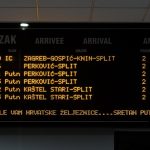Croatian airports are having a rather busy year…
According to Croatia’s Agency for Civil Aviation through Croatia’s airport, last year, 8.1 million passengers traveled through Croatian airports, which is 12.8% more than in 2015. Given the trend of passenger traffic growth in recent years, this year expects an increase in the number of passengers in domestic airports by about 10%, reports HRTurizam on August 6, 2017.
“Such a big increase in visitors, which has been recorded in Croatia’s airports year after year, is mostly influenced by the growth of GDP in the countries passengers are coming from, as well as many other factors which primarily include safety. Namely, tourists mostly decide to travel to destinations where they will feel safe,” said Tonći Peović, the President of the Air Transport Association at HGK. He added that the increase in traffic at Croatian airports, among other things, was also influenced by the air carriers themselves who reduced average ticket prices, which is, consequently, their reaction to lower oil commodity prices on the world market.
Because of this, the increase in air traffic in Croatia has also affected the short stay of tourists in some markets for about two to three days, thanks to online booking systems such as Booking.com or Airbnb.com.
“In the summer season, charter flights have been significantly activated. There is an intensification of air traffic towards Croatian tourist destinations, a higher frequency of already existing lines and the introduction of new aviation lines,” said Peović, adding that a crucial step forward was opening the Middle East hub, which exposes the markets of the Far East.
“Such dynamic growth in traffic, however, sets us ahead and challenges the capacity of airport buildings (runways, platforms, terminals, parking lots, access roads, human resources) that have to meet the peak load requirements, given that doubling traffic can be expected within seven years. Certainly, the process of building for such growth in Croatian conditions takes a long time. It is also necessary to define the final capacities of some airports so that preparations for moving to locations where new, undisturbed developments can begin in the decades that follow and will start on time,” explains Peović. He also underlines the need to highlight the effects of large-scale investment in airports that help the weak construction sector. Capital investments after Franjo Tudjman airport will take place at the airports of Dubrovnik, Split, and Brač, and the airports of Pula and Zadar will see the reconstruction of runways and maneuvering areas.
Total passenger traffic at Croatian airports in the first six months of 2017 amounted to 3,411,325 passengers. Compared to the same period of 2016, which saw 2,894,787 passengers, this is an increase of 17.7%, according to data from Croatia’s Agency for Civil Aviation. In the first six months of 2017, the largest growth in passenger numbers, when compared to the same period last year, was recorded by Brač Airport which had an increase of 50.9%. Franjo Tudjman Airport in Zagreb saw a 10.1% increase in passengers and Split Airport saw a 27.3% increase in passengers. Dubrovnik Airport recorded a growth in passengers of 20.4% percent. Pula airport saw the number of passengers increase by 37%, while Zadar Airport recorded a growth in passengers of 16.3%.
The total number of take-offs and landings at Croatian airports in the first six months of 2017 was 49,119, compared to 45,580 in the first half of 2016 – displaying an increase of 7.8%. The total freight traffic at Croatian airports in the first six months of 2017 was 3,264.5 tons, which was just 2,360.1 tons in the first half of 2016 – displaying an increase of 38.3% percent.
Translated from HRTurizam








